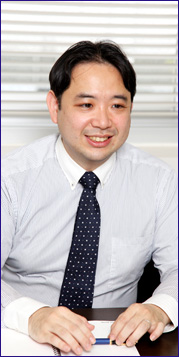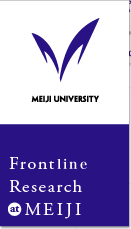

Experiencing the Gap between Academics and Reality
The first research I undertook after continuing on to graduate school involved data analysis methods that focused strongly on mathematical theory. However, as my research progressed, I increasingly suspected the presence of a gap between mathematically correct answers and reality, and I began to sense the limits of the type of approaches I was employing. At the time, I felt that my efforts would not be of much use in real-life problems. This led me to the discovery of my current specialty of statistical science, an academic field I think has closer ties to reality.After embarking on my studies in statistical science, I focused on research with applicability to real-life problems. My style of research remains unchanged to this day, and I personally believe that this style is the most effective way to solve real problems. However, I was aware that there are no all-purpose solutions, and I came to understand both the strengths and weaknesses of my approach. In this way I was able to recognize anew the importance of mathematical research. By moving back and forth between mathematical studies and studies more rooted in reality, I have come to understand that both approaches are important, and that the most important thing to aim for is a balance between the two.
Translating Real-life Phenomena into Mathematical Formulas
At present, I primarily utilize Bayesian statistics to extract new knowledge from time series and spatio-temporal data, and I also carry out research on future forecasting. I recently took part in collaborative research with a biologist to predict the hardness of cellular membranes over time based on microscopic cell imaging data. Statisticians often participate in biological research because of the enormous amounts of data involved, and in this particular case I was able to take on a new challenge by utilizing moving image data and mathematics as appropriate in the process of chronological analysis. Furthermore, I am involved in research on a method for circadian rhythm of mouse, estimation of submarine topography through utilization of tsunami models and tide gauge data, research on financial market trends at the time of the 2011 Great East Japan Earthquake, and other projects. I strive to contribute in such ways to the development of fundamental knowledge in scientific fields such as biology, as well as to applied research in medicine, disaster prevention, economics, and other areas. The challenge I confront in these various fields of applied research is how to translate real-life phenomena into mathematical formulas. Rather than concluding my efforts with simple creation of such formulas, I want to make connections between these formulas and real life to create functional models that are both accurate and useful to society. Moving forward, I intend to participate in joint research projects to broaden my views, to come into contact with various facets of reality, and to search out new methods of making statistics useful to society.Cultivating Human Resources with a Wide Range of Interests Who Can Contribute to Society
The basic principles of the Graduate School of Advance Mathematical Sciences revolve around practical application of phenomenology and mathematics that places a strong emphasis on relationships to factors such as society and nature. We welcome all potential students who have been unable to find clear problem-solving methods as an undergraduate or precise answers within their academic disciplines, those who are searching for a venue to apply their academic studies in real-life society, and those who are looking for ways to serve society. To start with, it is important to search out a subject or subjects that interest you personally, because once you find a research topic you feel passionately about there is a high likelihood it can be transformed into something that is useful to society. From there, I will ask you cultivate the ability to determine for yourself what needs to be done to achieve your research goals. I am expending my utmost effort to make cultivation of this type human resource possible.In the field of statistics, formulas are not mere armchair theories—there are many cases in which solutions cannot be obtained unless one faces reality directly. During the process of converting phenomena to numeric figures, the ability to see through to the true essence of things, to follow through completely, and to hold discussions with other people in a variety of fields are very important. I hope that all students will pursue a wide range of interests, determining what in themselves is lacking and discovering what is needed, in order to cultivate the ability to contribute to society in a wide range of ways.
Profile
Assistant Professor, Graduate School of Advanced Mathematical Sciences, Meiji UniversityBorn in Gunma Prefecture. Specializes in statistical science, with research focusing on Bayesian statistical analysis of spatio-temporal and time series data. Completed a doctoral degree (Ph.D.) in 2007 at the Department of Statistical Science, School of Multidisciplinary Sciences, The Graduate University for Advanced Studies (SOKENDAI). Served as a researcher at the Japan Science and Technology Agency CREST, a specially appointed researcher at The Institute of Statistical Mathematics (Research Organization of Information and Systems), and in other capacities before taking on his current position in 2011.










